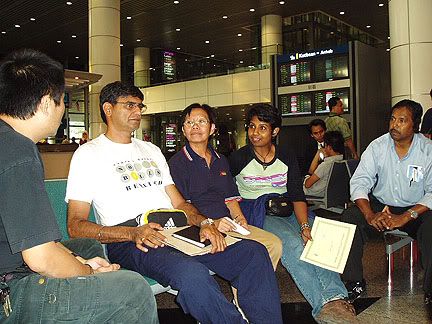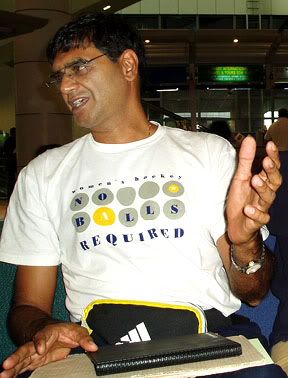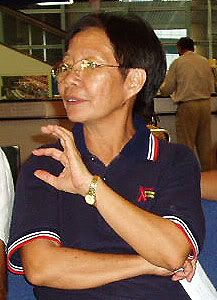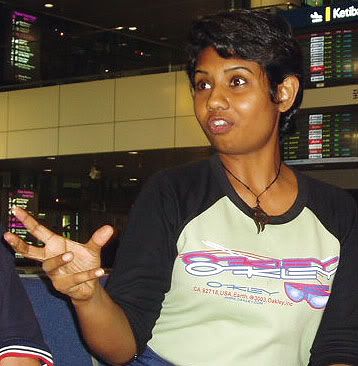Special report from SEAPCP Hokkaido - Activity of Aceh Relief
Dear friends,
Here is a personal letter from the coordinator of the Aceh Campaign in Hokkaido Japana. He is sharing about their involvement in the Tsunami issue and also reflections about the Aceh tsunami issue. From January to April, he and his colleagues collected donations amounting to about USD7,000 and they are still collecting some donations right now. They also did many activities to publicise the issues and educate the Japanese public about the issue, including a photo exhibition, lectures, school presentations, etc. Please read his letter and if you would like to respond to him please direct your emails to the email address below and your letters will be translated and sent to him. kayo sunazawa - kayomimijp@yahoo.co.jp
Jo Hann Tan
KOMAS Malaysia
------------------
Special report from SEAPCP Hokkaido
Activity of Aceh Relief
(Respect for peace & the mutual well being of one another for the future.)
When Japanese think about Asia countries and relate with people who are living in Asia, I think there are 3 points we should not forget: The first point is there are Japanese leaders who are "mad" and many Japanese people are obedient to them. In the past Asia people suffered great hardships because the Japanese committed a historical crime in the past. And until now, they didn't search their conscience about what they did to Asian people. It is not enough to do so international but also internally. This is the cause of many troubles and mistrust.
The second point is currently Japan society, economy, money and other fields are based on the sacrifice of Asia countries and its people. The third point is for our future, we must examine ourselves, learn together and achieve peace and mutual caring & helping one another. I think this is important.
I live in a small town in Hokkaido, the Northern Island in Japan. I publish a local magazine with my friends and use this magazine to appeal to the Japanese people that we are related to other Asian countries and the people who live in Asia. This is because this contributes greatly towards the future between Japan and other Asian people.
This plan of mine become true because the Ms. Kayo Sunazawa who is my very valuable friend and her husband, Mr.Tan Jo Hann. I respect him and he became my friend. He sent me that wonderful report and photos about the destruction of the tropical forests by Japanese companies in Sarawak in Malaysia. This report touched many readers' hearts. On of the readers is a junior high school student who decided to apply for studies with regard to global environment in Malaysia. He has passed the first exam and this is a very difficult exam and qualified by only five students in Japan.
Our plan is connect the living rooms of Japan and Asia to achieve peace and mutual concern for each other so we got the help of Mr.Tan Jo Hann and Ms. Kayo Sunazawa who has been helping us to put this plan into practice, little by little.
On 26th December 2004, many people who live in Sumatra Island and around the Indian ocean were stricken by an Earthquake and Tsunami. It brought much sorrow to many people. My friends and I responded to a call from Ms Kayo Sunazawa and immediately started support activities for the victims.
But this activity is not only charity. We think that Asia was then connected with and "a Japanese sitting room (inside a house) because the Japanese people could do something to achieve a mutual happy life. But Japanese have their own way of thinking and it is very important we understand the request from the victims and people who understand the situation like SEAPCP. As such my friends and I chose to cooperate in this way to the best of our ability.
What is the method of cooperation? The first thing we did was to spread accurate news about the affected areas. The second was to collect donations to help the victims. And through this activity, we had hoped that many Japanese people would take an interest in the Asia region and people living there. We also got the Japanese people to think about this situation and how it also affects Japan. This means we have started active support for the Aceh people and also for a better understanding for us in Japan. That's why we organized the Aceh photo exhibition and lectures because these activities were indispensable for us. Mr.Tan Jo Hann and Ms Kayo Sunazawa helped make these activities possible.
After the disaster happened, there was very little information about it in Japanese media, and so we planned the Aceh photo exhibition. When we suggested this plan to The Book Shop Association in our town, they offered cooperation. The Book Shop Association allowed SEAPCP Hokkaido to use the exhibition hall in the departmental store which is the most crowded place in our town. We exhibited 30 Aceh photos from Mr.Tan Jo Hann for 1 week.
In the exhibition, we showed our town map and indicate the line that if we have a Tsunami attack, how much of our town would be destroyed. So many people began to feel how serious and bad was the destruction to Aceh. We put donation boxes in 10 bookshops and were able to collect quite a lot of donation.
We had 2 lecture sessions. One was an induction course of the newspaper trade union confederation, and the theme was "reporting about a disaster". Fortunately, at that time this confederation had planned for a meeting near our town and so they asked me to give a lecture. I decided without hesitation to share with them about Aceh immediately. That day, I brought 40 Aceh photographs which Mr. Tan Jo Hann provided us, I presented those photos and explain about the actual situation of Aceh, SEAPCP and KSKBA’s relief activities. I also shared with them that a report about disaster is not for the newspaper company’s exploitation but must be for the victims.
One of participant asked me "what do you think about a reporting of disaster sometimes invading the victim’s privacy?". I said "If this report protect the victim’s lives and their property, the victims would be happy even if you invade their privacy".
I also told them about one scientist who predicted a volcano eruption in Hokkaido so he rescued many people's lives. He emphasized that "if the administration, the scientist, the mass media and residents were able to play their part and cooperate with each other, talk on equal basis then we can confine the damage to the least".
This is very important not only for our country, Japan, but for other countries as well. Unfortunately & usually, the administration is not efficient; the scientist is not knowledgeable and does not have the capacity; the mass media is concerned only with their exploitation; and the residents are poor in disaster prevention knowledge and they do not cooperate together. I think that SEAPCP and KSKBA are not only giving food and medicines but they have been trying to develop a better system for the relief and rehabilitation works. The other lecture was a snowstorm day but still 20 people attended. Some of participates donated considerably.
SEAPCP Hokkaido office is on the second floor of a very old apartment, Mr. Tan Jo Hann knows well. January and February is a very cold season and the water pipes were frozen and we could not use water in our office. I had to repair this so I jumped into the snow and push aside a lot of snow to reach the water pipe each time. I pour hot water onto the pipe to melt the ice inside the pipe.
Also on the snowstorm day, our window had blown off and strong and cold wind blew into our office. But that cold office has got very warm donation from many people. Almost all the donators are Ms. Kayo Sunazawa's friends who read Mr. Tan Jo Hann’s report in our magazine. One of the high school students in Aomori Prefecture had a consultation in the school about donations and they decided to collect donations for the Aceh people through SEAPCP Hokkaido. Also the high school students in our town came to our office and interviewed us to make a report for their own high school newspapers.
The activities of SEAPCP and KSKBA members receive sympathy from many people including students in Japan. Our SEAPCP Hokkaido members feel proud and thank SEAPCP and KSKBA members because we could tell Japanese people about your activity and feel useful to you. And we are waiting SEAPCP and KSKBA to call upon our help for the Aceh people to help them get back their peaceful life as soon as possible.
From:
Mr. Tomohiro Niinuma
SEAPCP Hokkaido, JAPAN
July 2005.






